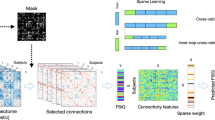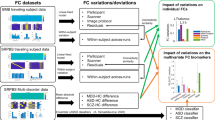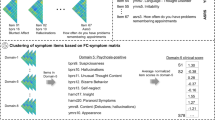Abstract
Clinical response to antipsychotic drug treatment is highly variable, yet prognostic biomarkers are lacking. The goal of the present study was to test whether the fractional amplitude of low-frequency fluctuations (fALFF), as measured from baseline resting-state fMRI data, can serve as a potential biomarker of treatment response to antipsychotics. Patients in the first episode of psychosis (n = 126) were enrolled in two prospective studies employing second-generation antipsychotics (risperidone or aripiprazole). Patients were scanned at the initiation of treatment on a 3T MRI scanner (Study 1, GE Signa HDx, n = 74; Study 2, Siemens Prisma, n = 52). Voxelwise fALFF derived from baseline resting-state fMRI scans served as the primary measure of interest, providing a hypothesis-free (as opposed to region-of-interest) search for regions of the brain that might be predictive of response. At baseline, patients who would later meet strict criteria for clinical response (defined as two consecutive ratings of much or very much improved on the CGI, as well as a rating of ≤3 on psychosis-related items of the BPRS-A) demonstrated significantly greater baseline fALFF in bilateral orbitofrontal cortex compared to non-responders. Thus, spontaneous activity in orbitofrontal cortex may serve as a prognostic biomarker of antipsychotic treatment.
Similar content being viewed by others
Log in or create a free account to read this content
Gain free access to this article, as well as selected content from this journal and more on nature.com
or
References
Kahn RS, Sommer IE, Murray RM, Meyer-Lindenberg A, Weinberger DR, Cannon TD, et al. Schizophrenia. Nat Rev Dis Prim. 2015;1:15067.
Potkin SG, Kane JM, Correll CU, Lindenmayer J-P, Agid O, Marder SR, et al. The neurobiology of treatment-resistant schizophrenia: paths to antipsychotic resistance and a roadmap for future research. NPJ Schizophr. 2020;6:1.
Demjaha A, Lappin JM, Stahl D, Patel MX, MacCabe JH, Howes OD, et al. Antipsychotic treatment resistance in first-episode psychosis: prevalence, subtypes and predictors. Psychological Med. 2017;47:1981–9.
Zhu Y, Li C, Huhn M, Rothe P, Krause M, Bighelli I, et al. How well do patients with a first episode of schizophrenia respond to antipsychotics: a systematic review and meta-analysis. Eur Neuropsychopharmacol. 2017;27:835–44.
Haddad PM, Correll CU. The acute efficacy of antipsychotics in schizophrenia: a review of recent meta-analyses. Ther Adv Psychopharmacol. 2018;8:303–18.
Robinson DG, Gallego JA, John M, Petrides G, Hassoun Y, Zhang J-P, et al. A randomized comparison of aripiprazole and risperidone for the acute treatment of first-episode schizophrenia and related disorders: 3-month outcomes. Schizophr Bull. 2015;41:1227–36.
Robinson DG, Woerner MG, Napolitano B, Patel RC, Sevy SM, Gunduz-Bruce H, et al. Randomized comparison of olanzapine versus risperidone for the treatment of first-episode schizophrenia: 4-month outcomes. Am J Psychiatry. 2006;163:2096–102.
Nordentoft M, Madsen T, Fedyszyn I. Suicidal behavior and mortality in first-episode psychosis. J Nerv Ment Dis. 2015;203:387–92.
Strålin P, Hetta J. Medication, hospitalizations and mortality in 5 years after first-episode psychosis in a Swedish nation-wide cohort. Early Intervention Psychiatry. 2019;13:902–7.
Buckley PF, Correll CU, Miller AL. First-episode psychosis: a window of opportunity for best practices. CNS Spectr. 2007;12:1–12. discussion 13-14; quiz 15–16.
Birchwood M, Todd P, Jackson C. Early intervention in psychosis. The critical period hypothesis. Br J Psychiatry Suppl. 1998;172:53–59.
Fond G, d’Albis M-A, Jamain S, Tamouza R, Arango C, Fleischhacker WW, et al. The promise of biological markers for treatment response in first-episode psychosis: a systematic review. Schizophr Bull. 2015;41:559–573.
Malhotra AK. Dissecting the heterogeneity of treatment response in first-episode schizophrenia. Schizophr Bull. 2015;41:1224–6.
Malhotra AK, Zhang J-P, Lencz T. Pharmacogenetics in psychiatry: translating research into clinical practice. Mol Psychiatry. 2012;17:760–9.
Chan NK, Kim J, Shah P, Brown EE, Plitman E, Carravaggio F, et al. Resting-state functional connectivity in treatment response and resistance in schizophrenia: a systematic review. Schizophrenia Res. 2019;211:10–20.
Mwansisya TE, Hu A, Li Y, Chen X, Wu G, Huang X, et al. Task and resting-state fMRI studies in first-episode schizophrenia: a systematic review. Schizophrenia Res. 2017;189:9–18.
Fox MD, Raichle ME. Spontaneous fluctuations in brain activity observed with functional magnetic resonance imaging. Nat Rev Neurosci. 2007;8:700–11.
Li A, Zalesky A, Yue W, Howes O, Yan H, Liu Y, et al. A neuroimaging biomarker for striatal dysfunction in schizophrenia. Nat Med. 2020;26:558–65.
Cui L-B, Cai M, Wang X-R, Zhu Y-Q, Wang L-X, Xi Y-B, et al. Prediction of early response to overall treatment for schizophrenia: a functional magnetic resonance imaging study. Brain Behav. 2019;9:e01211.
Wang Y, Jiang Y, Su W, Xu L, Wei Y, Tang Y, et al. Temporal dynamics in degree centrality of brain functional connectome in first-episode schizophrenia with different short-term treatment responses: a longitudinal study. Neuropsychiatr Dis Treat. 2021;17:1505–16.
Sarpal DK, Argyelan M, Robinson DG, Szeszko PR, Karlsgodt KH, John M, et al. Baseline striatal functional connectivity as a predictor of response to antipsychotic drug treatment. Am J Psychiatry. 2016;173:69–77.
Tarcijonas G, Foran W, Haas GL, Luna B, Sarpal DK. Intrinsic connectivity of the globus pallidus: an uncharted marker of functional prognosis in people with first-episode schizophrenia. Schizophr Bull. 2020;46:184–92.
Han S, Becker B, Duan X, Cui Q, Xin F, Zong X, et al. Distinct striatum pathways connected to salience network predict symptoms improvement and resilient functioning in schizophrenia following risperidone monotherapy. Schizophrenia Res. 2020;215:89–96.
Cao B, Cho RY, Chen D, Xiu M, Wang L, Soares JC, et al. Treatment response prediction and individualized identification of first-episode drug-naïve schizophrenia using brain functional connectivity. Mol Psychiatry. 2020;25:906–13.
Li H, Guo W, Liu F, Chen J, Su Q, Zhang Z, et al. Enhanced baseline activity in the left ventromedial putamen predicts individual treatment response in drug-naive, first-episode schizophrenia: results from two independent study samples. EBioMedicine. 2019;46:248–55.
Wu R, Ou Y, Liu F, Chen J, Li H, Zhao J, et al. Reduced brain activity in the right putamen as an early predictor for treatment response in drug-naive, first-episode schizophrenia. Front Psychiatry. 2019;10:741.
Kapur S, Remington G. Dopamine D(2) receptors and their role in atypical antipsychotic action: still necessary and may even be sufficient. Biol Psychiatry. 2001;50:873–83.
Kaar SJ, Natesan S, McCutcheon R, Howes OD. Antipsychotics: mechanisms underlying clinical response and side-effects and novel treatment approaches based on pathophysiology. Neuropharmacology. 2020;172:107704.
Wang L-X, Guo F, Zhu Y-Q, Wang H-N, Liu W-M, Li C, et al. Effect of second-generation antipsychotics on brain network topology in first-episode schizophrenia: a longitudinal rs-fMRI study. Schizophrenia Res. 2019;208:160–6.
Yao C, Hu N, Cao H, Tang B, Zhang W, Xiao Y, et al. A multimodal fusion analysis of pretreatment anatomical and functional cortical abnormalities in responsive and non-responsive schizophrenia. Front Psychiatry. 2021;12:737179.
Zou Q-H, Zhu C-Z, Yang Y, Zuo X-N, Long X-Y, Cao Q-J, et al. An improved approach to detection of amplitude of low-frequency fluctuation (ALFF) for resting-state fMRI: fractional ALFF. J Neurosci Methods. 2008;172:137–41.
Aiello M, Salvatore E, Cachia A, Pappatà S, Cavaliere C, Prinster A, et al. Relationship between simultaneously acquired resting-state regional cerebral glucose metabolism and functional MRI: a PET/MR hybrid scanner study. Neuroimage. 2015;113:111–21.
Nugent AC, Martinez A, D’Alfonso A, Zarate CA, Theodore WH. The relationship between glucose metabolism, resting-state fMRI BOLD signal, and GABAA-binding potential: a preliminary study in healthy subjects and those with temporal lobe epilepsy. J Cereb Blood Flow Metab. 2015;35:583–91.
Jiao F, Gao Z, Shi K, Jia X, Wu P, Jiang C, et al. Frequency-dependent relationship between resting-state fMRI and glucose metabolism in the elderly. Front Neurol. 2019;10:566.
Marchitelli R, Aiello M, Cachia A, Quarantelli M, Cavaliere C, Postiglione A, et al. Simultaneous resting-state FDG-PET/fMRI in Alzheimer disease: relationship between glucose metabolism and intrinsic activity. Neuroimage. 2018;176:246–58.
Sato JR, Biazoli CE, Moura LM, Crossley N, Zugman A, Picon FA, et al. Association between fractional amplitude of low-frequency spontaneous fluctuation and degree centrality in children and adolescents. Brain Connect. 2019;9:379–87.
Di X, Kim EH, Huang C-C, Tsai S-J, Lin C-P, Biswal BB. The influence of the amplitude of low-frequency fluctuations on resting-state functional connectivity. Front Hum Neurosci. 2013;7:118.
Yan C-G, Cheung B, Kelly C, Colcombe S, Craddock RC, Di Martino A, et al. A comprehensive assessment of regional variation in the impact of head micromovements on functional connectomics. Neuroimage. 2013;76:183–201.
Zuo X-N, Di Martino A, Kelly C, Shehzad ZE, Gee DG, Klein DF, et al. The oscillating brain: complex and reliable. NeuroImage. 2010;49:1432–45.
Küblböck M, Woletz M, Höflich A, Sladky R, Kranz GS, Hoffmann A, et al. Stability of low-frequency fluctuation amplitudes in prolonged resting-state fMRI. Neuroimage. 2014;103:249–57.
Turner JA, Chen H, Mathalon DH, Allen EA, Mayer AR, Abbott CC, et al. Reliability of the amplitude of low-frequency fluctuations in resting state fMRI in chronic schizophrenia. Psychiatry Res. 2012;201:253–55.
Kapur S, Phillips AG, Insel TR. Why has it taken so long for biological psychiatry to develop clinical tests and what to do about it? Mol Psychiatry. 2012;17:1174–9.
Lui S, Li T, Deng W, Jiang L, Wu Q, Tang H, et al. Short-term effects of antipsychotic treatment on cerebral function in drug-naive first-episode schizophrenia revealed by “resting state” functional magnetic resonance imaging. Arch Gen Psychiatry. 2010;67:783–92.
Woerner MG, Mannuzza S, Kane JM. Anchoring the BPRS: an aid to improved reliability. Psychopharmacol Bull. 1988;24:112–7.
Kahnt T, Chang LJ, Park SQ, Heinzle J, Haynes J-D. Connectivity-based parcellation of the human orbitofrontal cortex. J Neurosci. 2012;32:6240–50.
Rolls ET. Attractor cortical neurodynamics, schizophrenia, and depression. Transl Psychiatry. 2021;11:215.
Wallis JD. Orbitofrontal cortex and its contribution to decision-making. Annu Rev Neurosci. 2007;30:31–56.
Costa VD, Tran VL, Turchi J, Averbeck BB. Reversal learning and dopamine: a bayesian perspective. J Neurosci. 2015;35:2407–16.
Itahashi T, Noda Y, Iwata Y, Tarumi R, Tsugawa S, Plitman E, et al. Dimensional distribution of cortical abnormality across antipsychotics treatment-resistant and responsive schizophrenia. Neuroimage Clin. 2021;32:102852.
Akudjedu TN, Tronchin G, McInerney S, Scanlon C, Kenney JPM, McFarland J, et al. Progression of neuroanatomical abnormalities after first-episode of psychosis: a 3-year longitudinal sMRI study. J Psychiatr Res. 2020;130:137–51.
Mørch-Johnsen L, Nesvåg R, Faerden A, Haukvik UK, Jørgensen KN, Lange EH, et al. Brain structure abnormalities in first-episode psychosis patients with persistent apathy. Schizophr Res. 2015;164:59–64.
Kahnt T, Weber SC, Haker H, Robbins TW, Tobler PN. Dopamine D2-receptor blockade enhances decoding of prefrontal signals in humans. J Neurosci. 2015;35:4104–11.
Cole DM, Beckmann CF, Searle GE, Plisson C, Tziortzi AC, Nichols TE, et al. Orbitofrontal connectivity with resting-state networks is associated with midbrain dopamine D3 receptor availability. Cereb Cortex. 2012;22:2784–93.
Looijestijn J, Blom JD, Aleman A, Hoek HW, Goekoop R. An integrated network model of psychotic symptoms. Neurosci Biobehav Rev. 2015;59:238–50.
Kahnt T, Tobler PN. Dopamine modulates the functional organization of the orbitofrontal cortex. J Neurosci. 2017;37:1493–504.
Sarpal DK, Robinson DG, Lencz T, Argyelan M, Ikuta T, Karlsgodt K, et al. Antipsychotic treatment and functional connectivity of the striatum in first-episode schizophrenia. JAMA Psychiatry. 2015;72:5–13.
Cools R, Arnsten AFT. Neuromodulation of prefrontal cortex cognitive function in primates: the powerful roles of monoamines and acetylcholine. Neuropsychopharmacology. 2022;47:309–28.
Soltani A, Koechlin E. Computational models of adaptive behavior and prefrontal cortex. Neuropsychopharmacology. 2022;47:58–71.
Robbins TW, Clark L, Clarke H, Roberts AC. Neurochemical modulation of orbitofrontal cortex function. The orbitofrontal cortex. Oxford: Oxford University Press; 2006. 10.1093/acprof:oso/9780198565741.003.0016
Jalal B. The neuropharmacology of sleep paralysis hallucinations: serotonin 2A activation and a novel therapeutic drug. Psychopharmacology (Berl). 2018;235:3083–91.
Akkus F, Treyer V, Ametamey SM, Johayem A, Buck A, Hasler G. Metabotropic glutamate receptor 5 neuroimaging in schizophrenia. Schizophrenia Res. 2017;183:95–101.
Price RB, Gillan CM, Hanlon C, Ferrarelli F, Kim T, Karim HT, et al. Effect of experimental manipulation of the orbitofrontal cortex on short-term markers of compulsive behavior: a theta burst stimulation study. Am J Psychiatry. 2021;178:459–68.
Cao H, Wei X, Hu N, Zhang W, Xiao Y, Zeng J, et al. Cerebello-thalamo-cortical hyperconnectivity classifies patients and predicts long-term treatment outcome in first-episode schizophrenia. Schizophr Bull. 2022;48:505–13.
Maximo JO, Kraguljac NV, Rountree BG, Lahti AC. Structural and functional default mode network connectivity and antipsychotic treatment response in medication-naïve first episode psychosis patients. Schizophr Bull Open. 2021;2:sgab032.
Wang Y, Jiang Y, Collin G, Liu D, Su W, Xu L, et al. The effects of antipsychotics on interactions of dynamic functional connectivity in the triple-network in first episode schizophrenia. Schizophr Res. 2021;236:29–37.
Liang S, Wang Q, Greenshaw AJ, Li X, Deng W, Ren H, et al. Aberrant triple-network connectivity patterns discriminate biotypes of first-episode medication-naive schizophrenia in two large independent cohorts. Neuropsychopharmacology. 2021;46:1502–9. https://doi.org/10.1038/s41386-020-00926-y
Kottaram A, Johnston LA, Tian Y, Ganella EP, Laskaris L, Cocchi L, et al. Predicting individual improvement in schizophrenia symptom severity at 1-year follow-up: comparison of connectomic, structural, and clinical predictors. Hum Brain Mapp. 2020;41:3342–57.
Bergé D, Lesh TA, Smucny J, Carter CS. Improvement in prefrontal thalamic connectivity during the early course of the illness in recent-onset psychosis: a 12-month longitudinal follow-up resting-state fMRI study. Psychol Med. 2020:1–9.
Zhang Y, Xu L, Hu Y, Wu J, Li C, Wang J, et al. Functional connectivity between sensory-motor subnetworks reflects the duration of untreated psychosis and predicts treatment outcome of first-episode drug-naïve schizophrenia. Biol Psychiatry Cogn Neurosci Neuroimaging. 2019;4:697–705.
Blessing EM, Murty VP, Zeng B, Wang J, Davachi L, Goff DC. Anterior hippocampal–cortical functional connectivity distinguishes antipsychotic naïve first-episode psychosis patients from controls and may predict response to second-generation antipsychotic treatment. Schizophrenia Bull. 2020;46:680–9.
Kraguljac NV, White DM, Hadley N, Hadley JA, Ver Hoef L, Davis E, et al. Aberrant hippocampal connectivity in unmedicated patients with schizophrenia and effects of antipsychotic medication: a longitudinal resting state functional MRI study. Schizophr Bull. 2016;42:1046–55.
Anticevic A, Hu X, Xiao Y, Hu J, Li F, Bi F, et al. Early-course unmedicated schizophrenia patients exhibit elevated prefrontal connectivity associated with longitudinal change. J Neurosci. 2015;35:267–86.
Kraguljac NV, White DM, Hadley JA, Visscher K, Knight D, ver Hoef L, et al. Abnormalities in large scale functional networks in unmedicated patients with schizophrenia and effects of risperidone. Neuroimage Clin. 2016;10:146–58.
Hadley JA, Nenert R, Kraguljac NV, Bolding MS, White DM, Skidmore FM, et al. Ventral tegmental area/midbrain functional connectivity and response to antipsychotic medication in schizophrenia. Neuropsychopharmacology. 2014;39:1020–30.
Funding
This work was supported by grants from the National Institutes of Health: R01 MH108654 (PI: AKM); P50 MH080713 (PI: AKM); and R21 MH101746 (PIs: DGR and PRS).
Author information
Authors and Affiliations
Contributions
TL and AKM conceived the idea and designed this analysis of the data. AKM, DGR, PRS, and TL designed the overall longitudinal study. MLB and JAG supervised the longitudinal study and clinical phenotypes. TL ran the primary analyses, with assistance from AM, MA, ADB, MJ, and JC. TL drafted the manuscript. All authors read and provided scientific feedback, and participated in finalizing the draft of the manuscript.
Corresponding author
Ethics declarations
Competing interests
DGR has been a consultant to Acadia, Advocates for Human Potential, Amalyx, American Psychiatric Association, C4 Innovations, Costello Medical Consulting, Health Analytics, Innovative Science Solutions, Janssen, Lundbeck, Neurocrine, Neuronix, Otsuka, Teva, and US World Meds and has received research support from Otsuka. DGR also provides training and consultation about implementing NAVIGATE treatment that can include compensation. AKM has been a consultant to Genomind, InformedDNA, and Janssen. MLB is a consultant for HearMe and Northshore Therapeutics. JAG has served as a consultant to Alkermes. No other authors report competing interests.
Additional information
Publisher’s note Springer Nature remains neutral with regard to jurisdictional claims in published maps and institutional affiliations.
Rights and permissions
Springer Nature or its licensor holds exclusive rights to this article under a publishing agreement with the author(s) or other rightsholder(s); author self-archiving of the accepted manuscript version of this article is solely governed by the terms of such publishing agreement and applicable law.
About this article
Cite this article
Lencz, T., Moyett, A., Argyelan, M. et al. Frontal lobe fALFF measured from resting-state fMRI as a prognostic biomarker in first-episode psychosis. Neuropsychopharmacol. 47, 2245–2251 (2022). https://doi.org/10.1038/s41386-022-01470-7
Received:
Revised:
Accepted:
Published:
Issue date:
DOI: https://doi.org/10.1038/s41386-022-01470-7
This article is cited by
-
Altered spontaneous neural activity and its association with cognition, abdominal fat and liver function in children with obesity
Pediatric Research (2025)
-
Multi-feature fusion RFE random forest for schizophrenia classification and treatment response prediction
Scientific Reports (2025)
-
Differences in fractional amplitude of low-frequency fluctuations (fALFF) and cognitive function between untreated major depressive disorder and schizophrenia with depressive mood patients
BMC Psychiatry (2024)



